Boat Safety Tips
Sail and Powered Vessels Under 6m Equipment requirements
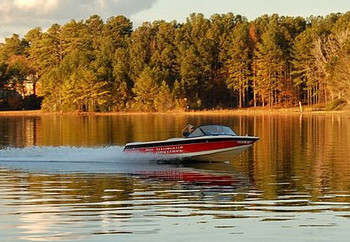
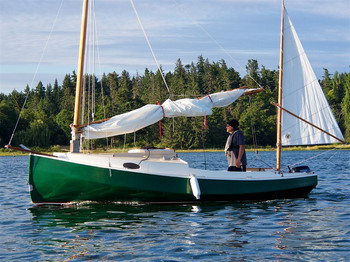
All powered vessels under 6 meters (20feet) in length are required to have:
- An appropriately sized, Canadian-approved personal flotation device (PFD ) or lifejacket, for each person on board
- A buoyant heaving line (15 meters in length)
- Manual propelling device or anchor with at least 15 meters of rope, cable or chain
- Bailer or hand pump
- Sound-signaling device
- Navigation lights if the craft is used between sunset and sunrise or during periods of reduced visibility, i.e. mist and rain
- A waterproof flashlight or 3 Canadian approved flares (type A, B or C flares)
- Reboarding device if Freeboard (distance from water to top of the vessel) is higher than 0.5m
- A class 5BC fire extinguisher if equipped with inboard engine, fixed fuel tank, or fuel burning appliance
Personal Water Craft Required Safety Equipment
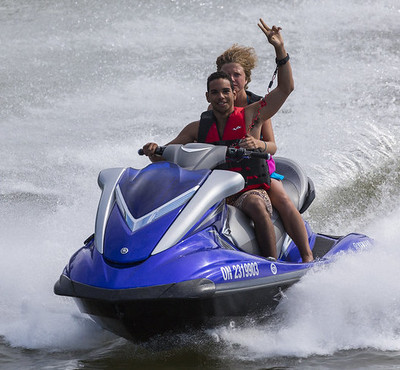
All Personal Water Craft (ie Seadoo) are required to have
- An appropriately sized, Canadian-approved personal flotation device (PFD ) or lifejacket, for each person on board
- A buoyant heaving line (15 meters in length)
- Manual propelling device or anchor with at least 15 meters of rope, cable or chain
- Bailer or hand pump
- Sound-signaling device
- Navigation lights if the craft is used between sunset and sunrise or during periods of reduced visibility, i.e. mist and rain
- A waterproof flashlight or 3 Canadian approved flares (type A, B or C flares)
- Reboarding device if Freeboard (distance from water to top of the vessel) is higher than 0.5m
- A class 5BC fire extinguisher if equipped with inboard engine, fixed fuel tank, or fuel burning appliance
If all persons on board are wearing a PFD then the required equipment is:
- An appropriately sized, Canadian-approved personal flotation device (PFD ) or lifejacket, for each person on board
- A buoyant heaving line (15 meters in length)
- Sound-signaling device
- Navigation lights if the craft is used between sunset and sunrise or during periods of reduced visibility, i.e. mist and rain
- A waterproof flashlight or 3 Canadian approved flares (type A, B or C flares)
- Reboarding device if Freeboard (distance from water to top of the vessel) is higher than 0.5m
Unpowered Vessels
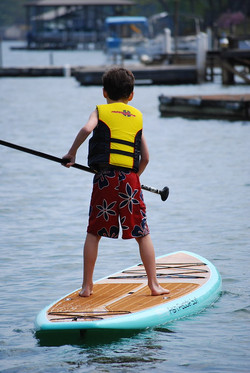
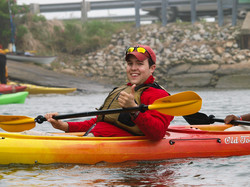
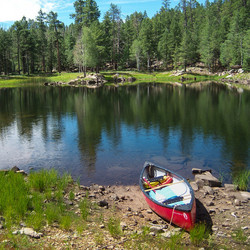
Unpowered vessels come in many forms but common ones are canoes, kayaks, paddleboards, watercycles, sailboards and kiteboards
- An appropriately sized, Canadian-approved personal flotation device (PFD ) or lifejacket, for each person on board
- A buoyant heaving line (15 meters in length)
- Manual propelling device or anchor with at least 15 meters of rope, cable or chain
- Bailer or hand pump
- Sound-signaling device (whistle or horn)
- Navigation lights or Flashlight if the craft is used between sunset and sunrise or during periods of reduced visibility, i.e. mist and rain
- Reboarding device if Freeboard (distance from water to top of the vessel) is higher than 0.5m
Paddleboards, Watercycles, Sailboards, and Kiteboards if everyone on board is wearing a PFD then the required equipment is:
If everyone is not wearing a PFD then all of the equipment listed above is required.
- An appropriately sized, Canadian-approved personal flotation device (PFD ) or lifejacket, for each person on board
- Sound-signaling device (whistle or horn)
- Navigation lights or Flashlight if the craft is used between sunset and sunrise or during periods of reduced visibility, i.e. mist and rain
- Reboarding device if Freeboard (distance from water to top of the vessel) is higher than 0.5m
Before you head out onto the water you need to check:
- The weather forecast
- That you have a proper fitting PFD or Lifejacket for everyone on board. Ideally wearing it.
- Check to make sure you have all of the required safety equipment, it is accessible, and in good working order
- Ensure everyone on boards knows where the safety equipment is
- Check your motor's mechanical components such as the propellor and oil to ensure everything is in good working order
- Ensure you you have enough fuel and use the rule of thirds. A third to get there, a third to get back, and a third just in case.
- Check to make sure you have your Pleasure Craft Operators card on you
- Make sure your cell phone and/or radio is charged
- Make a Float Plan
- Have practiced getting into the boat from the water
Make a Float Plan
Whether leaving for a few hours or several days, a float plan remains one of your most important lifesaving tools.
The sail plan holds information on the route you plan to take as well as details about your watercraft and the people accompanying you on board.
It is important to always leave a sail plan with a responsible person before setting out. The person should be advised to alert the appropriate authorities if you fail to return on schedule, so that they may come to your rescue.
Recommended Information for your Float Plan:
- Size, type, and colour of vessel
- Operators name, address, and telephone number
- Vessel's name and licence number
- Type of Engine
- Type of communication equipment
- Trip Details
- Departure Date and time
- Leaving from and destination
- Proposed route and stop overs
- Estimated time of arrival
- Number of people on board
Emergencies Afloat, what to do when it doesn't go to plan
Even with all the preperation in the world it is always possible that something will go wrong.
| The weather takes a turn for the worse | The weather can change rapidly and if you find yourself in sudden bad weather the most important thing to do is to find safe harbour. This means that you may not be going home or to a marina but any place on the shore that you can land the vessel and seek shelter. |
| Engine Trouble | First you want to ensure you keep control of your vessel, putting your anchor in the water attached to bow even if it does not touch the ground will turn your bow to face the waves. Call for help on your phone or radio If you have the tools, knowledge, and skills to try to fix the problem then you may attempt it. |
| Swamped Boat |
|
| Fire on Board | If a fire occours on board you will:
|
How to use your rescue equipment
This is a general guide to the use of safety equipment for the rescue of a person who is the water. Everyone should learn these skills in a Lifesaving course and also by practicing these skills before you go.
If someone is in trouble in the water than you should:
- Ensure you do not loose sight of them
- Ensure everyone has their PFD/Lifejacket on
- Always approach a victim into the wind so your boat does not get blown over top of them
- Set the motor to nuetral when you are close enough
Talk Rescue
From a dry, safe location, provide positive verbal support with clear, simple instructions about what to do. These would be the same actions you would do in a self rescue:
- From a safe out of water position tell the victim to “watch me, keep your head up, kick your feet, and grab the side.”
- Eye contact and positive encouragement can have immediate results on a victim at close range, without putting you in any danger.
- Coordinate with them to ensure you are able to position the vessel in a safe position to help them
Throw Rescue

If the victim is a short distance from shore and a suitable buoyant object is available, throw the object so the victim can grasp and use it for support.
Possible assists that you may throw to a victim may include:
- A spare PFD/lifejacket
- Wakeboard or tube
- Empty Cooler
- A pool noodle
- Boat cushins
- Anything that floats
Be careful not to hit the victim when throwing the object, you want the object to land in their hands.
- Take into account the wind speed and direction
- Tell them what you are doing at every step
- Throw the assist underhanded to not at the victim
- Once they have grasped the rescue aid it has become a talk rescue. Encourage the victim verbally, and direct them towards safety
If the assist has a line attached, such as your 15m bouyant heaving line, it makes it easier to rescue the victim as you can pull them in.
- Throw the rescue aid underhand when possible
- Do not tie the line to yourself so you are able to release the line if necessary to protect yourself
- Throw the line to just in front or behind the victim
- Once the victim has grasped the line back away from the water and kneel or lay down to lower your center of gravity. If space permits simply hold the line and keep walking backward.
Reach Rescue
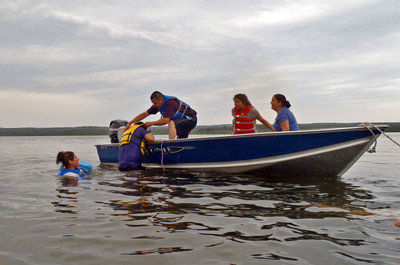
A reach rescue is used when there is no buoyant throwing assist and the victim is close enough to be reached with another aid such as a paddle or pole.
- Use a rescue assist, such as a paddle, extend it and pull the victim to safety
- Keep your center of gravity as low as possible. Anchor yourself by holding onto a solid object such as a tree root, ladder, or dock with your free hand. This will help prevent you from being pulled into the water.
- If no assist is available, you can reach directly with an arm or a leg from the prone position described above. Keep a firm hold on the pool edge, dock, or boat.
- You want to pull them to the side of the boat not to you





